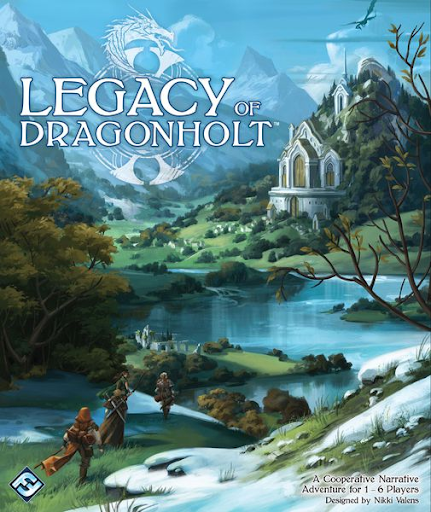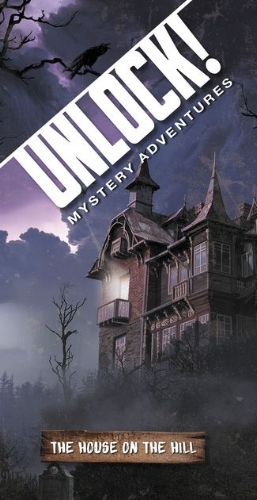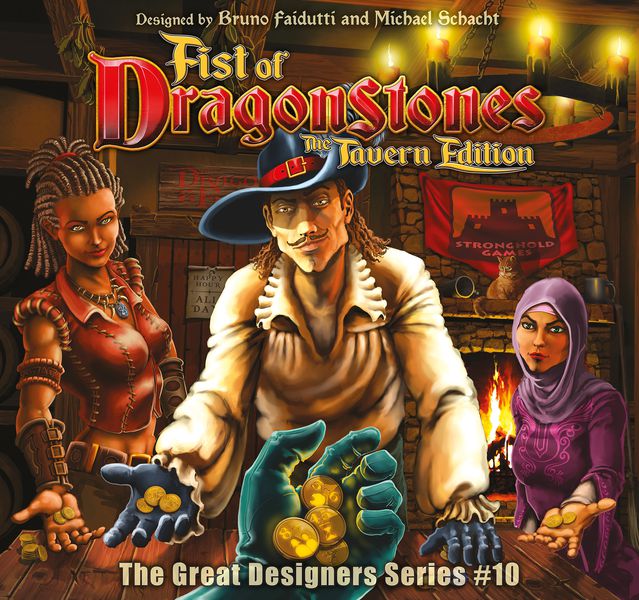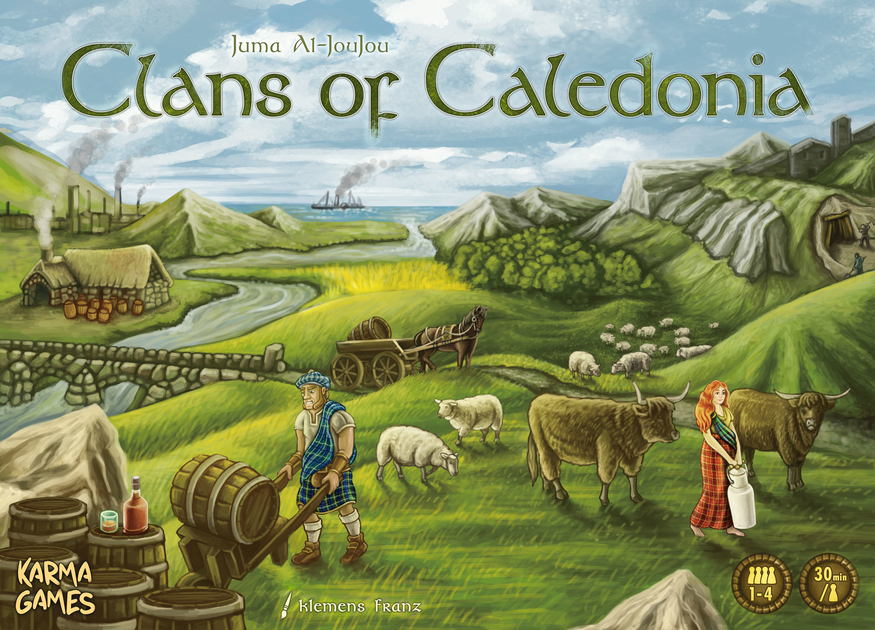Nyctophobia: Vampire Encounter
Designed by Catherine Stippell
Artwork by Peter Wocken
Published by Pandasaurus Games - 2018
3-5 players ~ 30-45 minutes
Review by Josh Simons
Nyctophobia is an odd game. There is something disorienting about the extensively tactile experience, where your touch and memory are forced into cohesion while completely isolated from your vision; it’s intriguing, weird, and even a bit alluring. At least, when you aren’t wearing the provided blackout glasses. But as strange as the cross wiring, synthetic, intentional blindness is, the oddity of Nyctophobia comes down more to design.
What the Phobia is Nycto?
Defined, nyctophobia is the fear of the dark. Immediately, I feel like I should be listening to Iron Maiden’s classic album, Fear of the Dark, but given the theme and feel of the game, a greatest hits album from Type O-Negative would be a most fitting vampiric selection (you music nerds know what’s up) but I’m getting side-tracked.
As far as the Pandasaurus Games catalog is concerned, Nyctophobia is published with two different versions available at retail, The Hunted (mass market release) and Vampire Encounter (Target exclusive), which seem to play the same at their core even if they sport mildly different themes. It comes down to which persona is pursuing the other players in the dark. For this review, Vampire Encounter is the sole version in experience.
In a one versus many style, one person plays the hunter, and two to four people play the hunted. In Vampire Encounter, one of the hunted friends (represented by a cardboard standee and dubbed “The Familiar” per the rule book) has run off into the dark labyrinthian woods with the creature of the night. Your goal is to leave the car, find your friend, and return to the car before any player has two encounters with the vampire. The hunted players are all wearing blackout glasses as they blindly search for clear paths through the trees that block them while trying to locate the foolish Familiar.
I Have A Phobia That Someone’s Always There
At the start of the game, the hunter sets up the modular board either in a configuration from the rulebook, another scenario (soon to be available) from Pandasaurus’ website, or of their own design. North, South, East, and West are predetermined so all players are oriented to the same directions. As a hunted player, you could see the board if you were not playing in the spirit of the game and peeking beneath your glasses, but otherwise you are at the mercy of the hunter. Seeing the board would compromise the game, as the difficulty and challenge come into play from the disorienting blindness.
Playing as one of hunted players doesn’t leave you utterly helpless in the darkness, though. Each hunted player receives two health tokens, a rock token which can be used in defense against the vampire, and a card that gives them an advantage such as the track star being able to move extra spaces or the cheerleader being able to give her actions to another player. Rocks can also be found in the forest.
On your turn, the hunter (vampire), takes your hand and places your finger onto your pawn to initiate the first portion of your turn, searching. You will explore the perpendicular spaces next to you, hoping you will only find open spaces, your fellow hunted players, or the Familiar. The pawns are differentiated by the indents on the top: a triangle, a gear, a plus, or a slot.
Being that most of us are so dependant on sight, it is completely disorienting to try and play a game designed to deprive you of this oft-taken-for-granted-sense; forcing you to rely on memory, touch, and the teamwork of those you’re playing with. While moving throughout these paths, it is vital for the hunted to communicate which direction they are heading and what they’re finding if there is any hope of finding the Familiar. When you slightly move out your finger to see what’s in the space around you, will you touch a tree, a fellow hunted player, or the dreaded smooth top of the vampire? If at any point you don’t know what you’re feeling, the hunter is to tell you. “That’s a row of trees”, “That’s a rock” “That’s Jack”. “That’s the west edge of the board”, “That’s the car”, “That’s me”.
After you’ve hesitantly determined your surroundings (hopefully with a distinct absence of vampires) you’re required to move two spaces for the movement portion of your turn. Sometimes this can be frustrating as you spend your movements to get yourself into a dead end, from which you’ll have to back track. It can feel like a wasted turn, but it will be helpful to consider it thematic to your nyctophobia.
After the hunted player searches and moves, there are actions that player has an option of doing one of. (1) Sprint, which allows for moving an extra space. (2) Leave the Familiar, which drops them next to you. (3) Hide, in which you flip your pawn upside down, leaving it with a circular divot in addition to your recognizable shape. This makes it so they are out of gameplay and combat. The player ceases to speak because they’re hiding, and if they do speak the noise token is placed on them for the vampire to pursue again. Thematically, it’s fun.
Hunter the Reckoning
The hunter has no nyctophobia since the role does not have the handicap of blackout glasses and therefore can see. The overwhelming advantage is mitigated by movement determined more by reactive programming than aggressive pursuit. Move towards the location of the noise token that has been dropped during the game, or if the noise token hasn’t been played, move towards the nearest hunted player. A deck of cards which you’ll play from provides variety to each of the vampires turns. The card you play could have you casting a hypnotic spell that moves the Familiar two spaces, or stalking a hunted player by removing the noise token, moving extra spaces, and creepily announcing, “The vampire is near.” If this all seems complicated while you’re trying to lure your friends into your clutches to feed, there is an included variant that simply allows the vampire to move two spaces in order to accommodate players who would prefer a more straightforward experience as the Hunter (great if you want your child to play as the marauding, bloodthirsty vampire). Once the Familiar is found, the cards have intensify effects on them to ratchet up the chase. If you were to cast your hypnotic spell at this point, the vampire would move the pawn of the player currently in possession of the Familiar instead of his own.
Should one of those meddling kids come in contact with the vampire, which happens at a mere physical and deflating touch, combat is initiated. The hunted loses one of their health tokens, may throw a rock in a counter attack (which reduces the vampires movement), retreat and hide. On the mechanics of hiding, the rulebook describes how to hide, but I don’t read any purpose in the function. I’m assuming that the vampire’s movement won’t take them toward a hiding player. It would make sense to play the game that way, but that’s an assumption due to the lack of clarity in the rulebook. The vampire backs off after taking a rock on the conk.
The game ends when either one of the hunter players recover and return the Familiar to the car, or one of the hunter player loses both of their health tokens.
Blood and Fire Out of the Ashes, and Sharp Nasty Teeth
Where Nyctophobia gets odd for me is that the hunter sets the mood of the experience by stalking, taunting, and claiming to be the terror that flaps in the night. In a way, the hunter is curating the game; they make the jokes or generate the fear, depending on the play style they’re going for. The rulebook does encourage you to get into character if you’re playing as the vampire. You see, Nyctophobia was designed out of the experiences Catherine Stippell had with her uncle, who is blind. She would guide him as they played board games together, serving him as a guide to make the time fun for both of them. It is almost as if the game runs itself, and the hunter player is cooperating with the hunted, yet not quite. It is easier experienced than explained.
What I have seen happen is for whoever is playing the role of the hunter will play it similarly to how they might play any other game. In reality, the hunter is the game master. This is your dark forest to saunter around in. These are your friends and family around the table with blackout glasses on who have put themselves completely in your care, trusting you that they will have fun playing a game that lasts a sightless 30-45 minutes. A poorly focused game can make Nyctophobia out stay its welcome quick.
If a hunter is unfamiliar with the rules of the game, this can make for a dreadful experience. Think back to every time you’ve sat in bored silence as the person teaching a game had to keep leafing through the rulebook. Imagine the slog of that while you can’t see anything. Time. Stands. Still. While. You’re. Waiting. On. What. Will. Happen. Next. It’s more tiresome to experience than reading that. On a side note, if you’re someone who tends to fall asleep during movies, like myself, it can become a matter of internal combat between staying awake and nodding off. With your sight blacked out and a hunter not engagingly moving the game forward at an appropriate pace, the struggle is real. In fact, I started writing this review during a game where I was a hunted player looking beneath my glasses to silently begin typing my thoughts out, just to keep myself alert with an unprepared vampire.
Bloody Kisses
There is so much potential for a genuinely scary and thrilling experience in this game. Unfortunately, though, there are a few things that break the immersive bubble of Nyctophobia’s gameplay. Most of these fall into the production of the game.
My biggest negative is that in every game I’ve played, the pawns will get stuck in the board. Trying to pull a smooth-sided, round-cornered stuck barrel pawn out of a hole that it perfectly fits into, all while you’re blind, breaks so much tension. Sure, the vampire is there to pick up the pieces, but the spooky gives way to fiddly.
Also, these blackout glasses are constantly worn through your experience as a hunted player. They functionally blind you to the game, but they don’t blind you to the light reflections from around the room to the back of the glasses, making for a very weird and rather uncomfortable sensation. My wife expressed the same concern. As an in-game temporary fix, I closed my eyes to keep from experiencing this. Since, we have opted for using sleep masks instead of the blackout glasses when playing as the hunted. I feel like this makes for a less weird sensory experience.
I feel like the rulebook is muddy. There’s a lot of information. On one hand it over explains some aspects, like how the hide action works mechanically and what rules bring a player out of hiding, while on the other hand, what benefit is there to hiding in the first place? There is enough context that I believe I can see, but that comes from years of gaming experience. To a newcomer, it would be hard to understand why actions are performed, let alone how the game is played. Adding to this difficulty, the long paragraphs of eye-glazing type font don’t make the rulebook any easier to discern, and the way it’s organized does not give a sense of the flow of gameplay. Pandasaurus Games has made the rulebook available at their website for your perusal.
Finally, is it just me, or was it a missed opportunity to not make these pieces glow in the dark?
Final Thoughts
All right, so a person playing the hunter can make or break Nyctophobia, but is there a game in the box or is it a gimmick? With sight, there is a low complexity game here. Without sight, there is a desperate search in the darkness that can create a sense of hopeless futility, enjoyable frustration, and tense awareness that something may be just beyond your senses. Nyctophobia has the capacity to invoke a sense of suspense or a load of laughs over the hunted players.
Nyctophobia isn’t going to scratch a highly strategic itch for anyone, unless you love the memory aspect of trying to remember the way out, but aside from a few production irritants, there is a partial evening of campy fun to be brought out with the right group of players. It’s in the family game collection for us, as the kids love playing it. If I were going to compare Nyctophobia to a movie, it would be The Blair Witch Project. It’s not for every time you want to play something, but it does fill a niche for when you want the kind of experience it offers. Fear, terror, a little hokey, still fun. Just manage your expectations and don’t turn into a ravenous beast of the night, when it turns out that the vampire without glasses is more lost in the woods than you.
Got questions about the game, the review, or the creative process? Let us know any we may tackle it when we publish our audio version with additional thoughts and Q&A on TCbH Reviews.
Josh Simons is a freelance writer and contributor to The Cardboard Herald. You can follow Josh and his creative projects on twitter, @oldroadcreative.
The Cardboard Herald is funded by the generous support of readers, listeners, and viewers. If you'd like to help support, you can find our Patreon here.





































